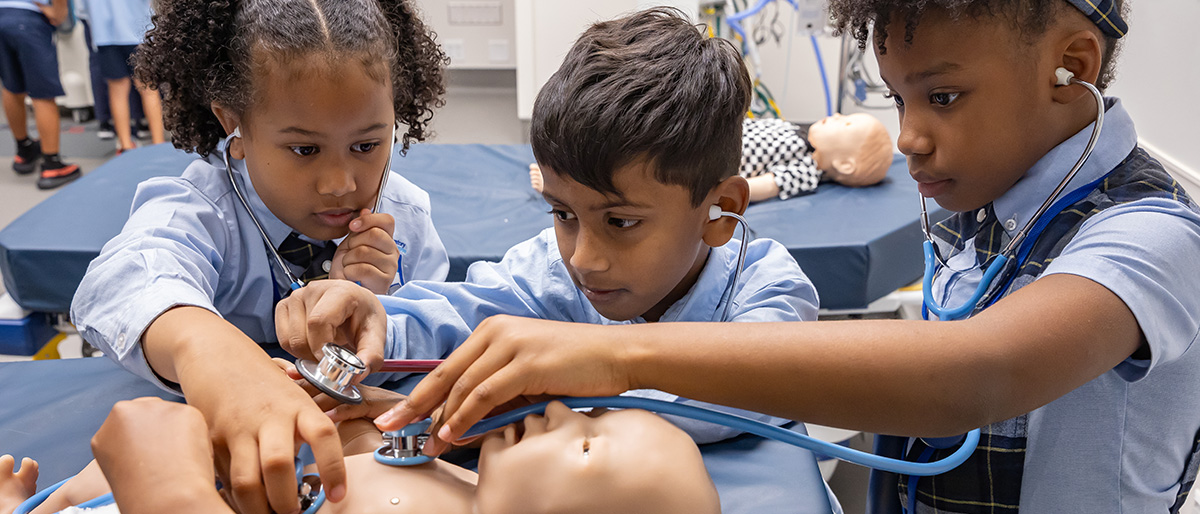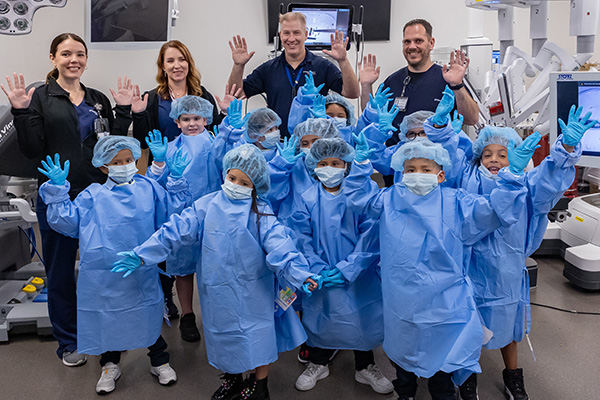Future doctors get a taste of futuristic learning
Biomedical Preparatory visits Simulation Center to experience how robotics is used in biomedical education

It’s not typical behavior for someone training with an endoscope to jump up and down in excitement. In this case, however, the response could be considered a success since the “trainees” were bright and energetic 7- and 8-year-olds learning about simulation-based medical technology at UT Southwestern.
In late October, 44 second grade students from Biomedical Preparatory at UT Southwestern got a taste of some of the newest innovations in health care education with a tour of the Simulation Center on West Campus.

At some stations, like the da Vinci robotic Surgical System, the children could look at innovative technology but not touch, while at other stops they could interact more closely, such as one with a manikin baby where they practiced taking vital signs and administering CPR. They also met “Karlie,” a manikin child that blinks, talks, and makes abnormal heart and lung sounds to simulate responses for learners to practice their skills on, which in this case was an emergency peanut allergy reaction.

“Call the nurse! I can’t breathe! I ate peanuts!” exclaimed Karlie (via a technician talking on a microphone in a control room), while the kids gathered around worriedly, calling out: “Nurse!”
Jeanne Carey, an Instructional Design Specialist at UTSW who on this date played the role of school nurse, rushed over to do an assessment. She checked Karlie’s heartbeat and airway, describing each step to the students.
“Does anyone want to listen to her?” Ms. Carey asked as she offered a stethoscope to a chorus of “Me!” “Me!” “Me!”

The field trip has become a regular event for the school, which opened on Forest Park Road on North Campus in 2022 through a partnership between UT Southwestern and the Dallas Independent School District. Biomedical Preparatory focuses on science, technology, engineering, and mathematics, along with social and emotional development, with the goal of preparing students for a constantly changing world.
Video: Highlights of the Sim Center field trip tour
A favorite stop on the tour featured a lesson on how the human body handles breathing and eating safely through the mouth, with snacks to make the lesson extra memorable.
“If air goes into the stomach, we burp; that’s all that happens,” said Rahm Heymann, UTSW Senior Simulation Educator. “So it’s not bad to let air into our stomachs. But it’s pretty bad to let food into your lungs.”

As students from a science-oriented school, they were up on most of the answers as Mr. Heymann quizzed them on anatomy.
“What’s the air tube?” he asked.
“The trachea!” students shouted in unison.
“What’s the food tube?”
“The esophagus!”
“What makes the body get the food and the air to the right place?”
After a long pause, a lone quiet voice spoke: “The … epiglottis?”
“Yes!” responded Mr. Heymann, clearly impressed.
And they’re fast learners too. Mr. Heymann used an endoscope to probe the trachea of a manikin, with a large video screen nearby showing the view from the probe’s camera. As he slowly withdrew the probe, he challenged the children to spot the guardian that keeps food out of the lungs. The kids all jumped when a flap, enormous on the screen, suddenly flopped into place.
“The epiglottis!” they yelled.
Parent chaperone Kristen Berry, a nurse, said she liked that the tour showed not only the medical aspects of caring for patients, but also a behind-the-scenes look at simulation technology.

“They get to see jobs that aren’t just ‘doctor,’” Ms. Berry said. “They love that there’s somebody whose job is to be in charge of the robots.”
After the tour, Ms. Carey said that it was fun for the staff to work with a different group from their usual medical students. “Hopefully, they learned something valuable that could serve them right now,” she said, “but also learned something for later, whether medicine or technology – they love the technology.”


